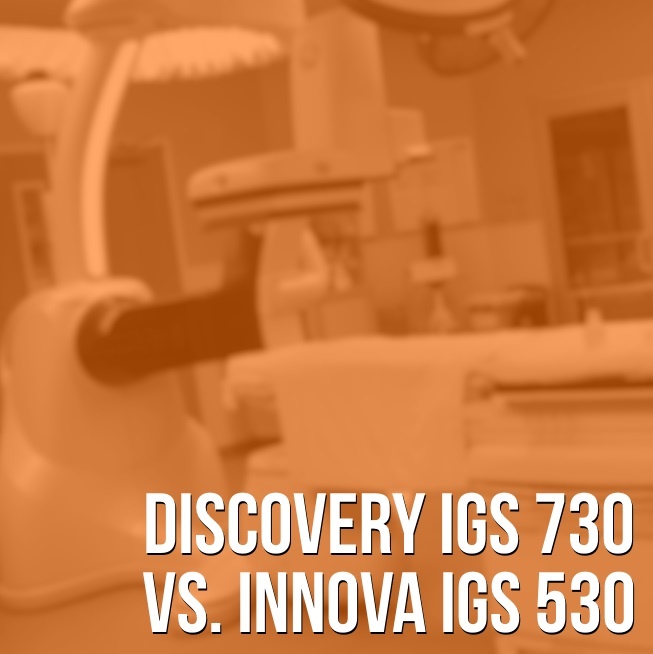
GE Healthcare has a long track record of pushing forward new advancements in interventional radiology. They also have a long track record of naming products with strings of numbers and initials that aren't as informative as one might hope. Their recent IGS labs are no exception, and the question has been put to us: "What is the difference between the GE Discovery IGS 730 and the GE Innova IGS 530?" To answer that, we took a deeper look at the specs of each system. Here's what we found:
What's the Same?
IGS Platform:Both the 730 and the 530 operate on GE's IGS (image guided system) platform. This means that they both have higher dose efficiency than earlier GE interventional models as well as patient dose tracking capabilities.
Configuration: Both models are also floor-mounted, single-plane, cardiovascular systems using GE's 31cm x 31cm Revolution digital detector. They also both use an 8-way horizontal float table capable of 20° Trendelenburg tilt and 12º reverse. This table also offers a 450 lb. weight capacity.
Acquisition: The 730 and 530 also share the same acquisition to 3D processing times at 25 seconds for 2563 and just 50 seconds for 5123.
Features: There are also a number of software features that both models bring to the user experience:
-
Innova TrackVision: Real-time guidance for needle intervention procedures
-
Innova 3D: 3D imaging acquisition from rotational angiography
-
InnovaChase: Unsubtracted bolus chase technique
-
InnovaBreeze: Subtracted bolus chase technique
-
InnovaSpin:Rotational acquisition using GE's proprietary DRM image processing algorithm
What's Different?
While the Discovery IGS 730 and the Innova IGS 530 have an awful lot in common, there a couple of major differences that need to be highlighted, one of which is a direct result of the other.
C-Arm Mobility: The gantry of the Discovery IGS 730 is essentially a giant mobile C-arm. You can think of it as a bigger, more powerful, and fully digital version of the OEC 9900 that is driven remotely from table-side controls to any of several pre-set, laser-guided locations. This kind of flexibility offers countless advantages in terms of workflow and accommodating the preference of individual surgeons and techs. It also opens up the OR for a wider variety of work to be done. The gantry of the Innova IGS 530 operates on a traditional, floor-mounted positioner.
Room Size Requirements: In order to take advantage of the mobile gantry of the 730, the minimum space required to install the system is greater- 22' x 17' (374 sq. ft.) versus 16' x 19' (304 sq. ft.) for the 530.
The Takeaway
If versatility in the OR is a priority for surgeons at your facility, the mobile gantry of the Discovery IGS 730 can deliver above and beyond any interventional system with a fixed positioner. If your surgery needs are more conventional, the Innova IGS 530 can bring you the same dose efficiency, acquisition speeds, and software features for a significantly lower price.
Both the 730 and the 530 are still very new systems and are virtually unfindable on the secondary market. If you have your heart set on either of these models, your most likely source for them will be GE, for somewhere in the ballpark of 800k to 1.5 million.
If you need an interventional solution sooner rather than later but can't swing the top-tier pricing of a new IGS lab, there are comparable alternatives on the secondary market that can meet your needs for a few years while the industry waits for first-wave Discovery 730 and Innova 530 systems to emerge from used and refurbished equipment providers. Below you'll find some options we suggest as well as links to learn more about them:
GE Innova 3100: Interventional Radiology Equipment: GE Innova 2100 vs 3100 vs 4100
Philips Allura FD10: Philips Allura FD10 vs. Allura FD20 Cath/Angio Comparison
Philips Allura FD20: GE Innova 4100 vs Philips FD20 Interventional Lab Comparison

Jeremy Block
Jeremy Block is the Senior Vice President of Product Solutions at Block Imaging. Jeremy’s goal is to make your buying or selling experience as easy as possible. Outside of work, Jeremy enjoys Michigan State football, and spending time with his wife and kids.





